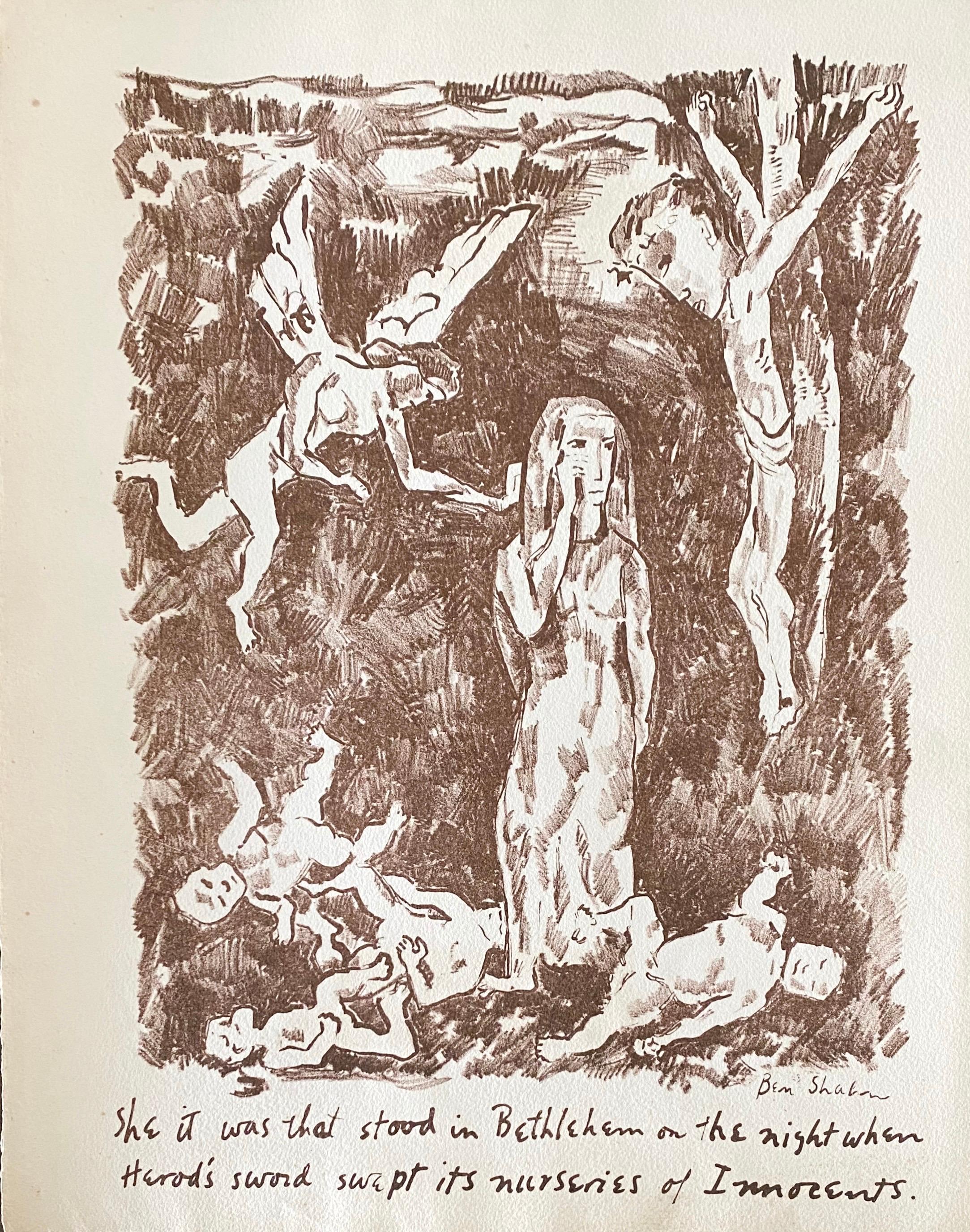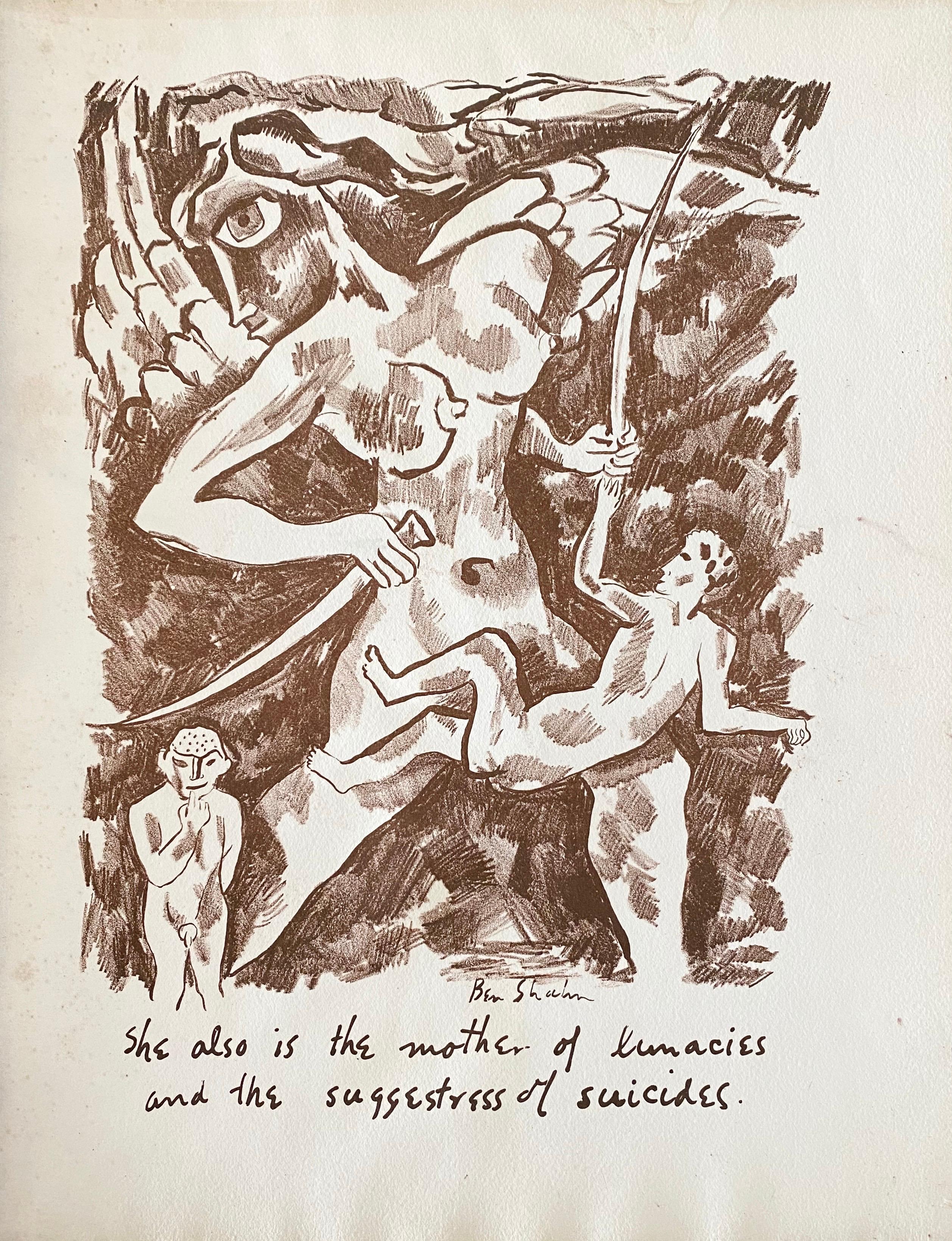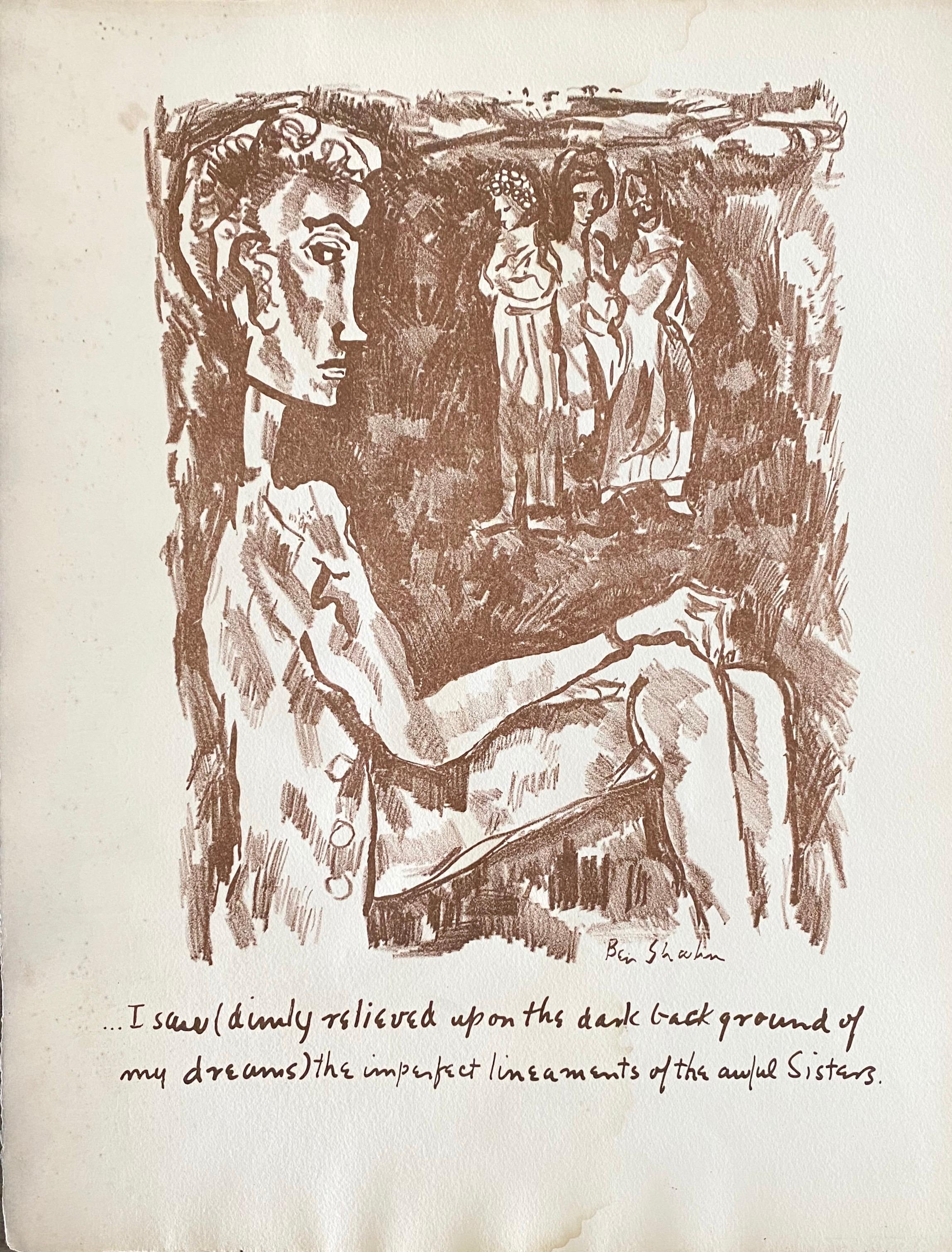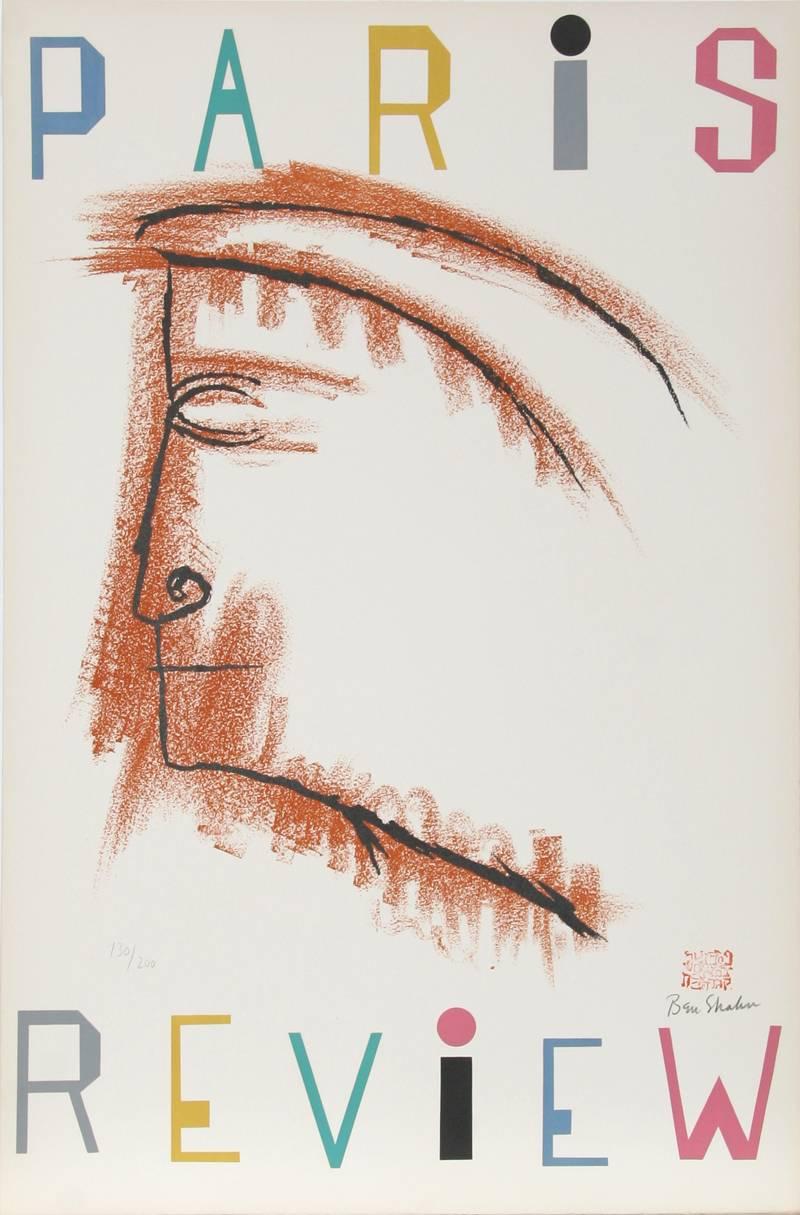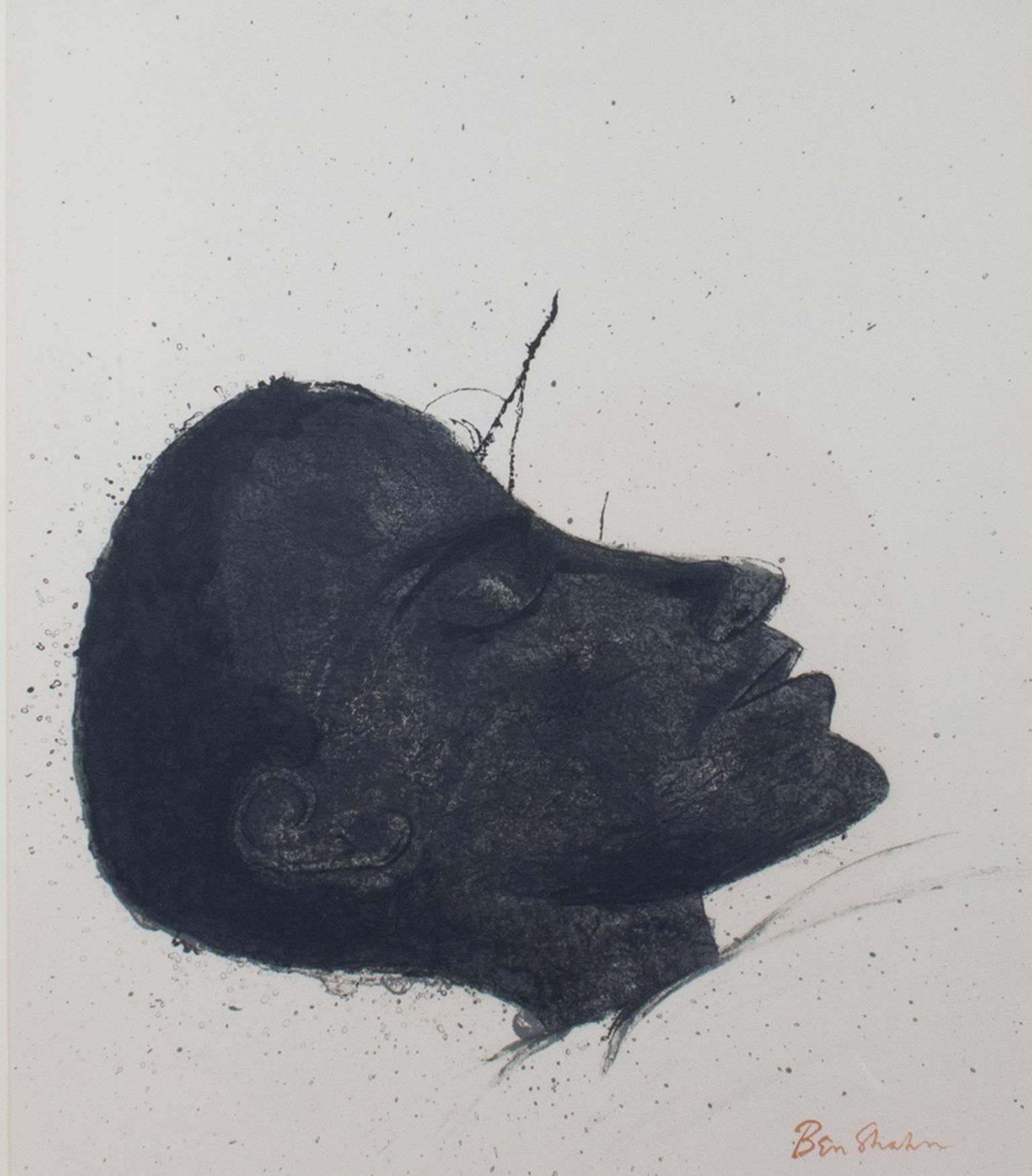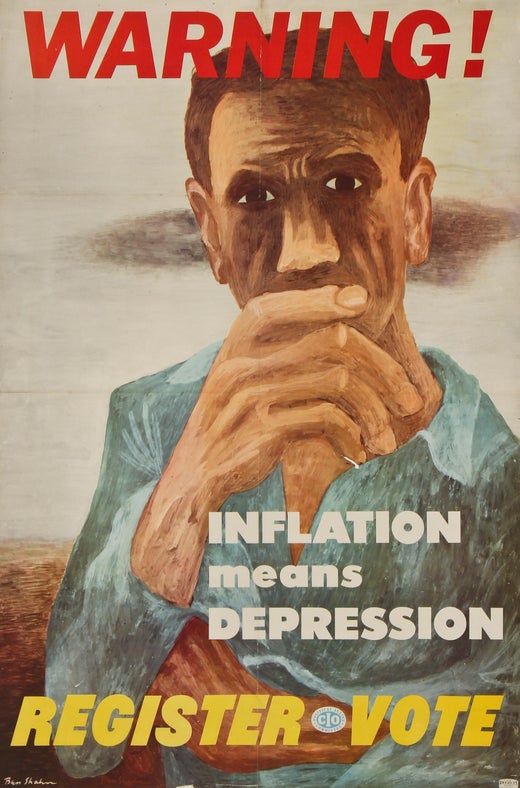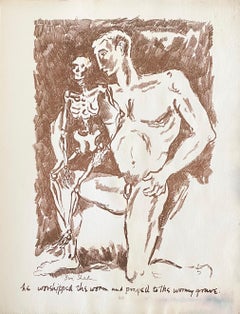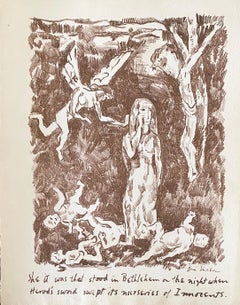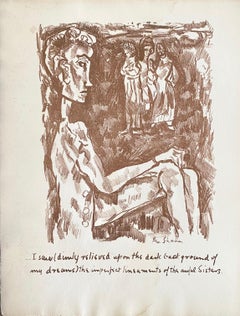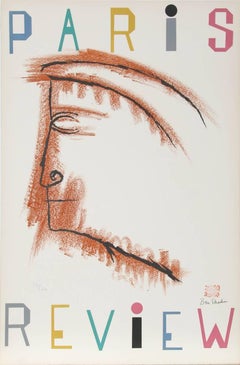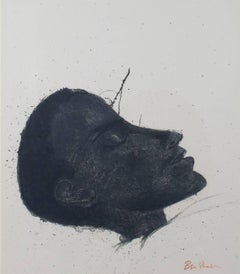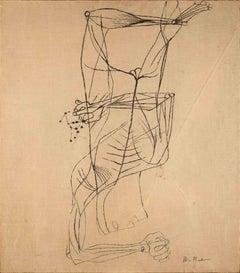Items Similar to Ben Shahn Original Lithograph From Portfolio - Levana & Our Ladies Of Sorrow
Want more images or videos?
Request additional images or videos from the seller
1 of 8
Ben ShahnBen Shahn Original Lithograph From Portfolio - Levana & Our Ladies Of Sorrow1931
1931
$1,100
£857.11
€972.37
CA$1,580.95
A$1,740.78
CHF 902.67
MX$20,615.56
NOK 11,458.79
SEK 10,709.54
DKK 7,262.44
About the Item
SCARCE EARLY WORK. BEN SHAHN
Levana and our Lady's Sorrows.
lithograph printed in sepia on Papier Ancien, 1931. 13 1/8x9 7/8 inches (sheets), full margins, loose as issued.
One of only 12 numbered copies, of a total edition of 212. Plate signed by the artistPublished by Philip van Doren Stern.
A scarce example of the artist's earlier work as a printmaker. According to Prescott, "Shahn recalled that only about 10 copies were sold and that he destroyed the remainder of the edition in anger and frustration. There are records of portfolios at the Brooklyn Museum, the Museum of Modern Art, and the Princeton University Library." Prescott 87-96.
Ben Shahn (September 12, 1898 – March 14, 1969) was a Jewish Lithuanian-born American artist. He is best known for his works of social realism, his left-wing political views, and his series of lectures published as The Shape of Content.
Shahn was born in Kaunas, Lithuania, then part of the Russian Empire, to Jewish parents Joshua Hessel and Gittel (Lieberman) Shahn. Shahn began his path to becoming an artist in New York, where he was first trained as a lithographer. Shahn's early experiences with lithography and graphic design is apparent in his later prints and paintings which often include the combination of text and image. Shahn's primary medium was egg tempera, popular among social realists.
Although Shahn attended New York University as a biology student in 1919, he went on to pursue art at City College in 1921 and then at the National Academy of Design. After his marriage to Tillie Goldstein in 1924, the two traveled through North Africa and then to Europe, where he made "the traditional artist pilgrimage." There he studied great European artists such as Henri Matisse, Raoul and Jean Dufy, Georges Rouault, Pablo Picasso and Paul Klee. Contemporaries who would make a profound impact on Shahn's work and career include artists Walker Evans, Diego Rivera and Jean Charlot.
In May and June 1933, he served as an assistant to Diego Rivera while Rivera executed the Rockefeller Center mural. Shahn had a role in fanning the controversy, by circulating a petition among the workers. Also during this period, Shahn met photojournalist Bernarda Bryson, who would later become his second wife. Although this marriage was successful, the mural, his 1934 project for the Public Works of Art Projects (WPA) and proposal for the Municipal Art Commission were all failures. Fortunately, in 1935, Shahn was recommended by Walker Evans, a friend and former roommate, to Roy Stryker to join the photographic group at the Resettlement Administration (RA). As a member of the group, Shahn roamed and documented the American south together with his colleagues Walker Evans and Dorothea Lange. Like his earlier photography of New York City, Shahn's photography for the RA and its successor, the FSA, Farm Security Administration, can be viewed as social-documentary. In 1939, Shahn and his wife produced a set of 13 murals inspired by Walt Whitman's poem I See America Working and installed at the United States Post Office-Bronx Central Annex.
During the war years of 1942–43, Shahn worked for the Office of War Information (OWI), but his pieces lacked the preferred patriotism of the day and only two of his posters were published. His art's anti-war sentiment found other forms of expression in a series of paintings from 1944–45, such as Death on the Beach, which depicts the desolation and loneliness of war. In 1945 he painted Liberation about the Liberation of Paris which depicts children playing in the rubble.He also did a series, called Lucky Dragon, about the Daigo Fukuryū Maru (literally, Lucky Dragon No. 5), the Japanese fishing boat caught in the Bikini Atoll hydrogen bomb blast. As of 2012, an important part of this series is in the collections of Fukushima Prefectural Museum of Art.
From 1961 to 1967, Shahn worked on the stained glass at Temple Beth Zion, a Buffalo, NY synagogue designed by Harrison and Abramovitz.
Shahn also began to act as a commercial artist for CBS, Time, Fortune and Harper's. His well-known 1965 portrait of Martin Luther King, Jr. appeared on the cover of Time. By the mid-1950s, Shahn's accomplishments had reached such a height that he was sent, along with Willem de Kooning, to represent the United States at the 1954 Venice Biennale. He was also elected to the American Academy of Arts and Sciences, the National Institute of Arts and Letters and the Academia dell' Arte e del Disegno in Florence.
Select Exhibitions
"Ben Shahn: Paintings and Drawings," 1930, Edith Halpert's Downtown Gallery NYC
"57th Annual American Exhibition: Water Colors and Drawings," 1946, Tate Gallery in London, England
"Ben Shahn: A Retrospective," 1947, Museum of Modern Art in New York, New York
"Esposizione Biennale internationale D’Arte XXVII," 1954 in Venice, Italy
"Ben Shahn," 1962, Palais des Beaux-Arts in Brussels, Belgium; Galleria Nazionale D'arte Moderna in Rome, Italy; and Albertina in Vienna, Austria.
"The Collected Prints of Ben Shahn," 1969, Philadelphia Museum of Art in Pennsylvania.
- Creator:Ben Shahn (1898-1969, American)
- Creation Year:1931
- Dimensions:Height: 13.13 in (33.36 cm)Width: 9.88 in (25.1 cm)
- Medium:
- Movement & Style:
- Period:
- Condition:Minor toning, small stains and wear. Please see Photos.
- Gallery Location:Surfside, FL
- Reference Number:1stDibs: LU38215139322
Ben Shahn
Ben Shahn (1898 – 1969) was a Lithuanian-born American artist. He is best known for his works of social realism, his left-wing political views, and his series of lectures published as The Shape of Content. Shahn began his path to becoming an artist in New York, where he was first trained as a lithographer. Shahn's early experiences with lithography and graphic design is apparent in his later prints and paintings which often include the combination of text and image. Shahn's primary medium was egg tempera, popular among social realists. Shahn mixed different genres of art. His body of art is distinctive for its lack of traditional landscapes, still lifes, and portraits. Shahn used both expressive and precise visual languages, which he coalesced through the consistency of his authoritative line. Shahn is also noted for his use of unique symbolism, which is often compared to the imagery in Paul Klee's drawings. His art is striking but also introspective. He often captured figures engrossed in their own worlds. Although he used many mediums, his pieces are consistently thoughtful and playful.
About the Seller
4.9
Platinum Seller
Premium sellers with a 4.7+ rating and 24-hour response times
Established in 1995
1stDibs seller since 2014
1,836 sales on 1stDibs
Typical response time: 1 hour
- ShippingRetrieving quote...Shipping from: Surfside, FL
- Return Policy
More From This Seller
View AllBen Shahn Original Lithograph From Portfolio - Levana & Our Ladies Of Sorrow
By Ben Shahn
Located in Surfside, FL
SCARCE EARLY WORK. BEN SHAHN
Levana and our Lady's Sorrows.
lithograph printed in sepia on Papier Ancien, 1931. 13 1/8x9 7/8 inches (sheets), full margins, loose as issued.
One of o...
Category
Mid-20th Century American Modern Figurative Prints
Materials
Lithograph
Ben Shahn Original Lithograph From Portfolio - Levana & Our Ladies Of Sorrow
By Ben Shahn
Located in Surfside, FL
SCARCE EARLY WORK. BEN SHAHN
Levana and our Lady's Sorrows.
lithograph printed in sepia on Papier Ancien, 1931. 13 1/8x9 7/8 inches (sheets), full margins, loose as issued.
One of o...
Category
Mid-20th Century American Modern Figurative Prints
Materials
Lithograph
Ben Shahn Original Lithograph From Portfolio - Levana & Our Ladies Of Sorrow
By Ben Shahn
Located in Surfside, FL
SCARCE EARLY WORK. BEN SHAHN
Levana and our Lady's Sorrows.
lithograph printed in sepia on Papier Ancien, 1931. 13 1/8x9 7/8 inches (sheets), full margins, loose as issued.
One of o...
Category
Mid-20th Century American Modern Figurative Prints
Materials
Lithograph
Ben Shahn Original Lithograph From Portfolio - Levana & Our Ladies Of Sorrow
By Ben Shahn
Located in Surfside, FL
SCARCE EARLY WORK. BEN SHAHN
Levana and our Lady's Sorrows.
lithograph printed in sepia on Papier Ancien, 1931. 13 1/8x9 7/8 inches (sheets), full margins, loose as issued.
One of o...
Category
Mid-20th Century American Modern Figurative Prints
Materials
Lithograph
Ben Shahn Original Hand Signed Litho WPA Artist Rilke Poem Lithograph Portfolio
By Ben Shahn
Located in Surfside, FL
"To Days of Childhood That are Still Unexplained". It depicts six female silhouette figures in long dresses or coats against a blue and pastel purple background. From the Rainier Ma...
Category
1950s American Modern Figurative Prints
Materials
Lithograph
Israeli Expressionist Yosl Bergner Modernist Lithograph
By Yosl Bergner
Located in Surfside, FL
Hand signed in Hebrew Lower right. Dimensions: H 19.5" x 13.5"
Bergner, Yosl (Vladimir Jossif) (b Vienna, 13 Oct 1920). surrealist, surrealism. belongs to the generation of people...
Category
Mid-20th Century Modern Figurative Prints
Materials
Lithograph
You May Also Like
Paris Review, Modern Art Lithograph by Ben Shahn
By Ben Shahn
Located in Long Island City, NY
Artist: Ben Shahn, American (1898 - 1969)
Title: Paris Review
Year: 1968
Medium: Lithograph on Arches, Signed in black crayon, numbered in pencil
Edition: 200
Paper Size: 39 x 26 in....
Category
1960s American Modern Figurative Prints
Materials
Lithograph
"Beside the Dying, " an Original Lithograph signed by Ben Shahn
By Ben Shahn
Located in Milwaukee, WI
"Beside the Dying" is an original signed lithograph by Ben Shahn. This print is from the series "For the Sake of a Single Verse" and depicts the head of a man in dark gray seemingly asleep or dead on a white background. It is signed lower right and is edition 27/200.
22" x 17" art
32 3/8" x 27 3/8" frame
Ben Shahn (American, September 12, 1898 - March 14, 1969) was a painter, lithographer, and photographer best known for his left-wing political leanings, works of social realism, and The Shape of Content, a publication of his lectures. Shahn was born in Kovno, Lithuania, when the country was still occupied by the Russian Empire. In 1902, Shahn's father, Joshua Hessel, was exiled to Siberia. Shahn then moved to Vilkomir, Lithuania, with his mother, Gittel, and his two siblings. Their family moved to the United States in 1906 to join their father who had fled from exile. After settling in Brooklyn, NY, Shahn began to train in lithography and graphic design, and his favorite medium was egg tempera. In 1919, Shahn enrolled in New York University to study Biology before entering the City College in 1921 to study Art. He also studied Art at the National Academy of Design. In the 1920s, Shahn and his wife traveled around Africa and Europe to study the works of renowned artists such as Pablo Picasso (Spanish, 1881- 1973) and Raoul Dufy (French, 1877-1953).
In 1933, Shahn worked as an assistant of Diego Rivera (Mexican, 1886 - 1957); at this time, Rivera was working on the mural at the Rockefeller Center in New York. Two years later, Shahn was recommended by Walker Evans (American, 1903 - 1975) to join the Farm Security Administration photographic group. One of the artist’s most famous works is the fresco mural he did for the Jersey Homesteads' community center. Shahn also worked on murals for the state on the Federal Security Building and the Bronx Central Annex Post Office.
During the Second World War, Shahn made a series of paintings laced...
Category
1960s Portrait Prints
Materials
Lithograph
Partings Long Seen Coming from the Rilke Portfolio
By Ben Shahn
Located in Long Island City, NY
Artist: Ben Shahn, American (1898 - 1969)
Title: Partings Long Seen Coming from the Rilke Portfolio
Year: 1968
Medium: Lithograph on Richard de Bas, si...
Category
1960s American Realist Figurative Prints
Materials
Lithograph
Untitled - Mixed Media by Ben Shahn - 1950s
By Ben Shahn
Located in Roma, IT
Untitled is an drawing realized by Ben Shahn (Kovno 1898-New York 1969)
Pen drawing on paper applied on canvas.
Hand-signed lower right: Ben Shahn.
Some light folds and discoloring...
Category
1950s Contemporary Figurative Drawings and Watercolors
Materials
Canvas, Mixed Media, Paper
$5,602 Sale Price
30% Off
Frontispiece from the Rilke Portfolio, Minimalist lithograph by Ben Shahn
By Ben Shahn
Located in Long Island City, NY
Artist: Ben Shahn, American (1898 - 1969)
Title: Frontispiece (Portrait) from the Rilke Portfolio
Year: 1968
Medium: Lithograph on Arches, signed in the plate
Edition: 750
Size: 22.5...
Category
1960s Modern Figurative Prints
Materials
Lithograph
original lithograph
By Ben Shahn
Located in Henderson, NV
Medium: original lithograph. This lithograph was printed in 1955 for the "Improvisations" portfolio, and published by the Artists Equity Association of New York in an edition of 2000...
Category
1950s Prints and Multiples
Materials
Lithograph
More Ways To Browse
Japanese Boat
Japanese Woodblock Samurai
Jason Boyd Kinsella
Jason Boyd
Jean Michael Basquiat
Jules Cheret Musee Grevin
Julian Opie Lenticular
Julie Torres
Jurgen Kuhl
Kaws Untitled
Keith Haring Best Buddies
Keith Haring David Bowie
Keith Haring Future Primeval
Kin Choi Lam
Kunisada Triptych
La Petite Corrida
Leon Boullet
Leroy Neiman Posters

